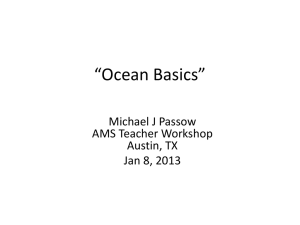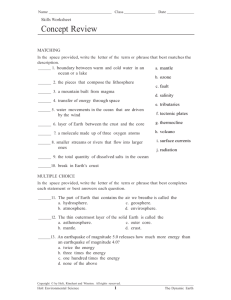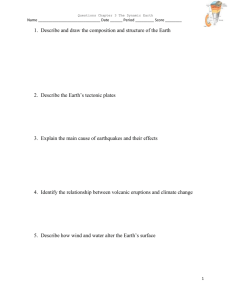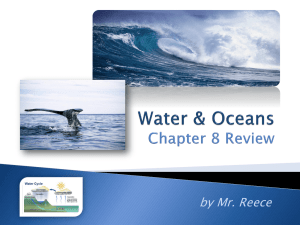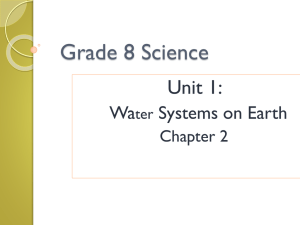the ocean floor
advertisement
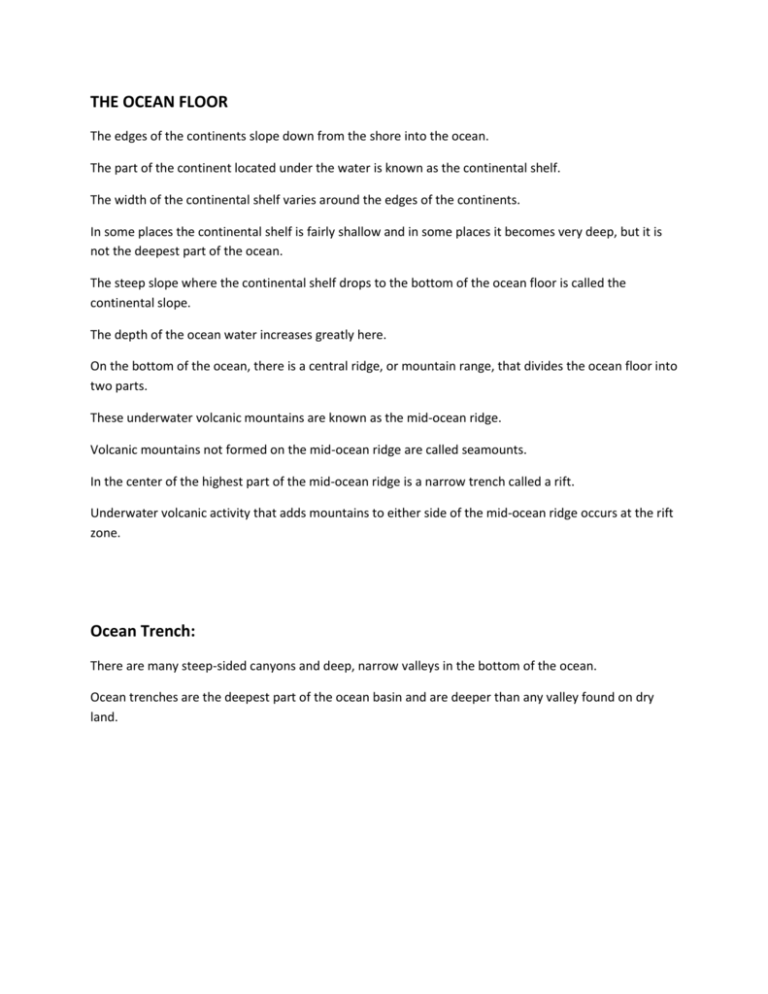
THE OCEAN FLOOR The edges of the continents slope down from the shore into the ocean. The part of the continent located under the water is known as the continental shelf. The width of the continental shelf varies around the edges of the continents. In some places the continental shelf is fairly shallow and in some places it becomes very deep, but it is not the deepest part of the ocean. The steep slope where the continental shelf drops to the bottom of the ocean floor is called the continental slope. The depth of the ocean water increases greatly here. On the bottom of the ocean, there is a central ridge, or mountain range, that divides the ocean floor into two parts. These underwater volcanic mountains are known as the mid-ocean ridge. Volcanic mountains not formed on the mid-ocean ridge are called seamounts. In the center of the highest part of the mid-ocean ridge is a narrow trench called a rift. Underwater volcanic activity that adds mountains to either side of the mid-ocean ridge occurs at the rift zone. Ocean Trench: There are many steep-sided canyons and deep, narrow valleys in the bottom of the ocean. Ocean trenches are the deepest part of the ocean basin and are deeper than any valley found on dry land. OCEAN BASIN: Located on either side of the mid-ocean ridge is the ocean basin. It is made up of low hills and flat plains. The flat area of the ocean basin is called the abyssal plain. Seamounts are generally formed on the ocean basin. SEAMOUNTS are volcanic areas under the ocean than could one day become an island. VOLCANIC ISLANDS: Hawaii and Japan are volcanic islands. Each island was formed by seamounts that grew to become islands by volcanic erupts happening over and over. 5-3.3 Compare continental and oceanic landforms. Earth is made of solid land. Some of the land is located above Earth’s water and some is located below the oceans. Explain how landforms above the oceans are similar to those found below the oceans. (glue your chart here) 5-3.4 Explain how waves, currents, tides, and storms affect the geologic features of the ocean shore zone (including beaches, barrier islands, estuaries, and inlets). The ocean shore zone, or coast, is the area where the land meets the ocean. Some shorelines are rocky. Shorelines made of sand are called beaches. Shorelines are always changing because of wind and water. Waves can wear away the land and expose a rocky shore or the waves can deposit sand along the shore and form a beach. If the waves reach the beach at an angle, the sand is moved along the coast. CURRENTS Flowing streams of water that move continually through the ocean in a specific direction are called currents. Some currents flow at the ocean’s surface and some are found deeper in the ocean. Currents, called longshore currents, along the shoreline can move sand from one location to another. Surface currents are caused by the movement of Earth and by the force and direction of wind. The movement of Earth and winds cause these currents to flow along curved paths. Warm water and cold water are moved to different regions on Earth as a result of currents. Warm surface currents are driven by Earth’s rotation from the tropics to higher latitudes. Cold surface currents are driven by Earth’s rotation from the polar latitudes toward the equator. Tides can bring in sand, shells, and ocean sediments at high tide and leave them behind when the tide goes out (low tide.) Storms can cause wave action that removes sand from beaches (like in hurricanes!) BARRIER ISLANDS: Islands are pieces of land surrounded by water on all sides. Islands with sandy beaches are called barrier islands. These barrier islands are naturally occurring and function to protect the mainland from the effects of waves on its shore. As the waves deposit sand on the beaches, the shapes of the barrier islands change. Currents can move the sand from one end of the island to the other. Estuaries: All rivers eventually flow into the oceans. The area where a river meets the ocean is known as an estuary. Estuaries have a mixture of freshwater and saltwater. Waves can deposit sand in the estuaries. At high tide ocean water brings in sediments and sea life that feed and nourish life in the estuary. Inlets are the water-filled spaces between the barrier islands. As the tides change, the amount of water in the inlet will change. Ocean currents and storms can change the shape of an inlet opening. Large storms, for example hurricanes, can also cause massive destruction to the shape of the beaches, barrier islands, estuaries, and inlets because they produce high waves and heavy winds. 5-3.5 Compare the movement of water by waves, currents, and tides. EXPLAIN THE THREE WAYS WATER CAN MOVE ON EARTH: 1. WAVES: The repeated movement of water is known as a wave. All waves have the same parts. The highest part is known as the crest and the lowest part is known as the trough. Most ocean waves are caused by winds that are blown across the surface of the water. A wave changes shape when it reaches the shore. 2. CURRENTS: Flowing streams of water that move continually through the ocean in a specific direction are called currents. Some currents flow at the ocean’s surface and some are found deeper in the ocean. Surface currents are caused by the movement of Earth and by the force and direction of wind. The movement of Earth and winds causes these currents to flow along curved paths. Warm water and cold water are moved to different regions on Earth as a result of currents. Warm surface currents are driven by Earth’s rotation from the tropics to higher latitudes. Cold surface currents are driven by Earth’s rotation from the polar latitudes toward the equator. 3. TIDES: Several times during the day, the level of water at the ocean shore changes. This regular rise and fall of waters in oceans and seas is called a tide. Tides are caused by the pull of the Moon’s gravity on Earth. As the Moon moves in relation to Earth, the water on Earth moves too. As Earth spins on its axis, the part of the ocean facing the moon will bulge. High tide occurs when the water level is at its highest point. Low tide occurs when the water level is at it lowest point. Tides rise and fall about twice a day. (visit StudyJams on the internet to see a cool video about tides!) 5-3.6 Explain how human activity (including conservation efforts and pollution) has affected the land and the oceans of Earth. • Resource: A supply that meets a need for materials or energy. • Resources may include air, water, trees, rocks and minerals, soil, or coal and oil. • Conserve: To use wisely. Having a positive impact: We can: Conserve resources The wise use of natural resources is called conservation. • Human activities that help to keep the natural resources of Earth available and clear of pollution are conservation efforts. • Some efforts involve everyone trying to reduce (use less of something), reuse (use something over again), and recycle (make something new from an old product). • Other efforts involve trying to save the land and oceans through clean-up projects, installing fence lines to prevent dune erosion or jetties along the entrance to harbors or groins along beaches in an effort to keep sand from washing away. • The idea behind building groins on beaches is to prevent beach erosion, but they work about half-right. The beach is built up on one side of the groin but is severely eroded on the other side. Beaches and "permanent" barriers don't mix! • Beach re-nourishment projects help to restore sand on beaches. • Planting trees, bushes, or grass is a way to improve air quality as well as keep erosion from carrying away soil. POLLUTION: Pollution is anything that harms the natural environment. When the taking or using of natural resources causes harm to Earth’s air, water including oceans, or land, then the human activity has caused pollution. Oceans are rich in food, minerals, and other resources and can be easily polluted. Human activities can also harm the land and oceans causing resources to be polluted or destroyed. Sometimes people may allow materials to be dumped into rivers not thinking that rivers flow into the estuaries and ocean where they are harmful to life there. Careless dumping of trash on land or in oceans pollutes those areas. Smoke and fumes from burning fuels pollutes the air. Oil spills harm the oceans and can cause life there to be killed. Careless human activities in agriculture, industry, construction, or mining can cause pollution on the land, in the water, and in the air. • MINING: The process of removing a resource from the ground. • We mine coal (a fossil fuel) and iron (used in steel). • Mining can be harmful by: changing habitats, causing pollution, increasing erosion when plants and topsoil are stripped from an area. • DRILLING: We drill for oil and other fossil fuels. • Drilling can be harmful because it changes landforms and pollutes water resources and soils. • OIL SPILLS: Can kill living things in ocean ecosystems. • Very difficult to clean up. • Can damage large areas for long periods. • Limit the Damage to Earth’s Oceans: recycle as much as you can. Reduce your use of resources, reuse materials, and
